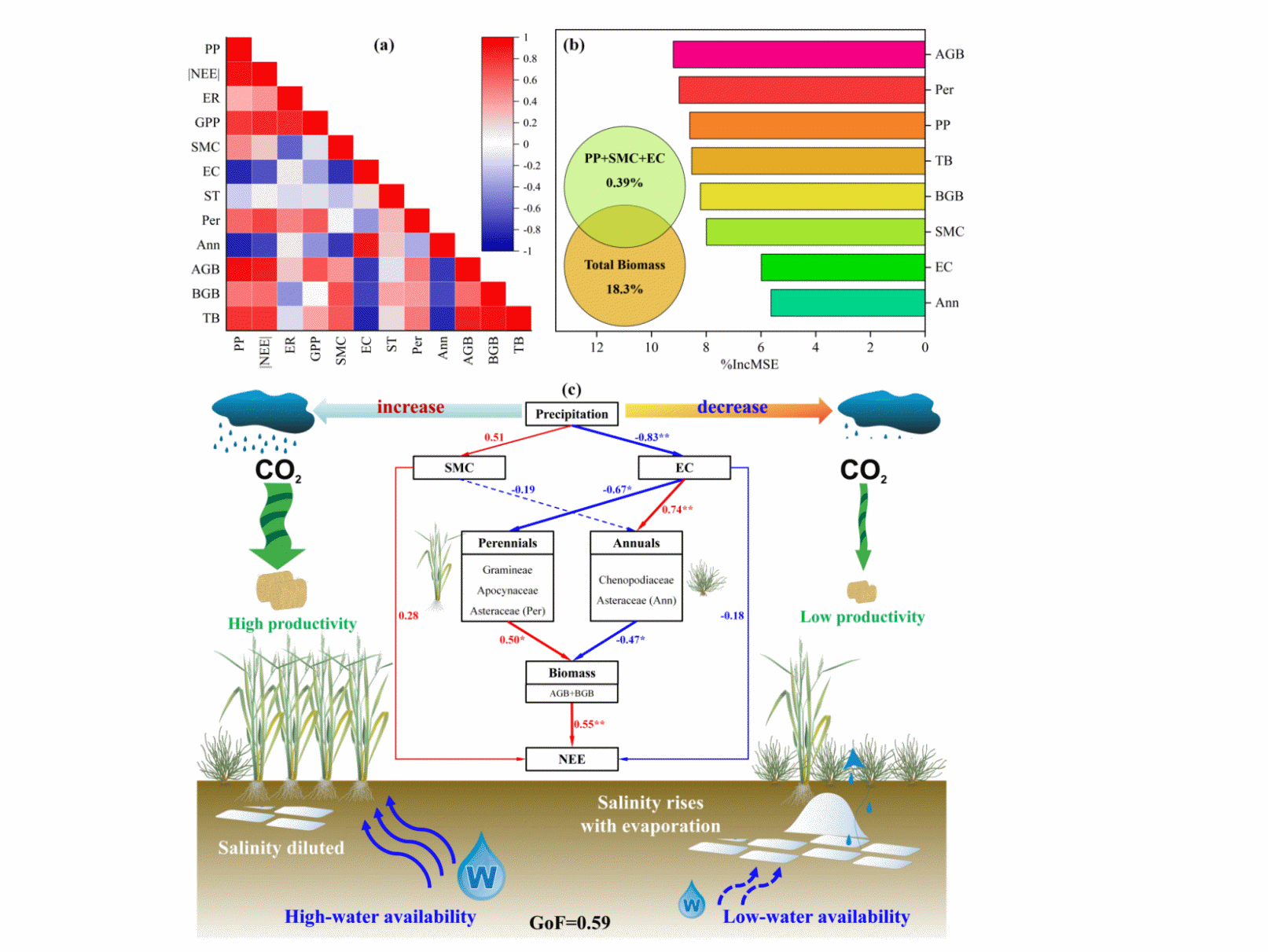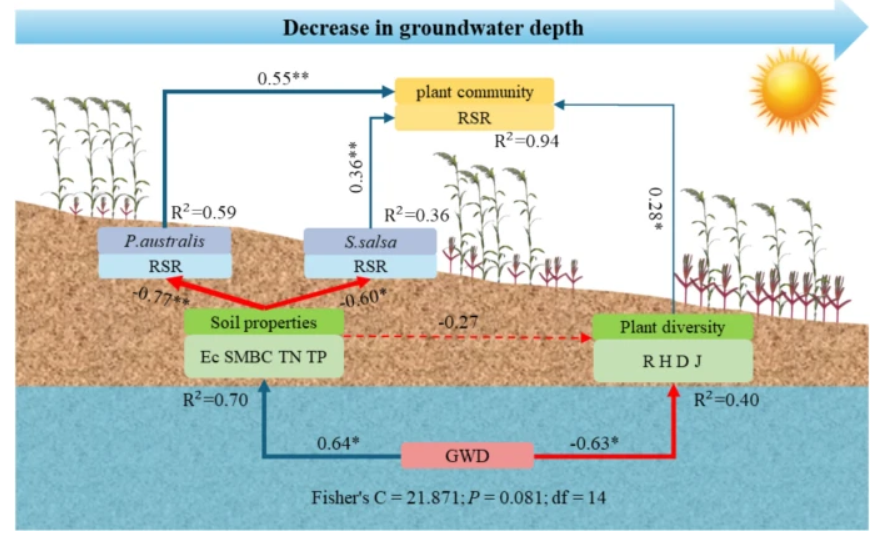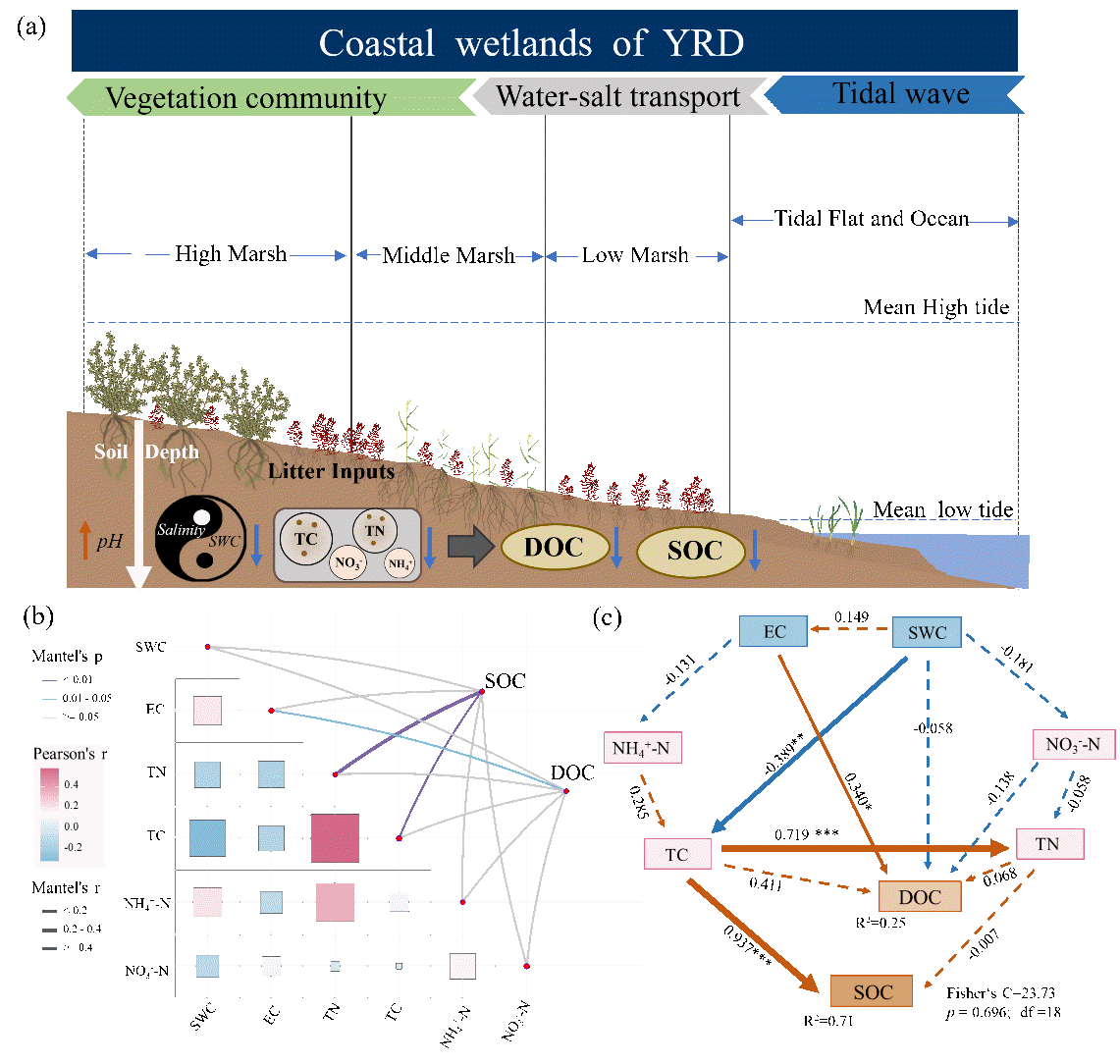| Research |
| Location:Home > Research > Research Progress |
| Yantai Institute of Coastal Zone Research make progress in Wetland Plant Community Responses and Ecosystem Functions |
Wetlands are vital ecosystems that provide a range of ecological functions, including carbon sequestration, water purification, climate regulation, and biodiversity maintenance.With the intensification of global warming, environmental factors such as changes in precipitation, fluctuations in groundwater levels, and alterations in soil moisture and salinity conditions are profoundly affecting the structure and function of wetland plant communities.Recently, relying on the Yellow River Delta Field Observation and Research Station of Coastal Wetland Ecosystem of the Chinese Academy of Sciences, the research team led by Han Guangxuan at theYantai Institute of Coastal Zone Research conducted a series of studies. These studies encompassed experiments on genotypic richness manipulation of Phragmites australis, simulated changes in precipitation, groundwater level regulation, and soil organic carbon (SOC) dynamics under various vegetation types.These studies revealed how wetland plants respond to environmental changes, and further explored how changes in plant communities affect ecosystem multifunctionality, net ecosystem CO₂ exchange (NEE), and the spatial distribution of SOC. Based on the Yellow River Delta Field Observation and Research Station of Coastal Wetland Ecosystem, the researchers conducted a common garden experiment to examine the relationship between the genotypic richness of Phragmites australis and ecosystem multifunctionality (Fig. 1).The results indicated that in the coastal wetlands of the Yellow River Delta, the genotypic richness of P. australis had differential effects on various ecosystem functions (EFs), and notably exerted a significant negative impact on soil bacterial richness.Further analysis revealed that with increasing genotypic richness, the average index of ecosystem multifunctionality showed a declining trend, which may be attributed to inter-genotypic competition leading to a reduction in overall ecosystem multifunctionality.Moreover, under different ecosystem function thresholds (i.e., the proportion of function indicators reaching their maximum values, set at 20%, 40%, and 60%), higher genotypic richness promoted a greater number of function indicators to reach their maximum values.However, at a higher threshold level (80%), higher genotypic richness instead reduced the number of ecosystem function indicators reaching their maximum values.Therefore, increased plant genotypic richness may weaken ecosystem multifunctionality, and the potential impacts of introducing new genotypes should be carefully assessed to avoid impairing ecosystemmultifunctionality (Zhang et al., 2025, Global Ecology and Conservation).
Figure 1. The relationship between genetic diversity and ecosystem functions (EFs). Relying on the precipitation gradient manipulation experimental platform, a three-year (2020-2022) monitoring was conducted to investigate net ecosystem CO₂ exchange (NEE) and the composition of plant life forms (perennials vs. annuals) (Fig. 2). The results showed that under all treatment conditions, the wetland acted as a CO₂ sink (NEE < 0). Soil salinity variation induced by precipitation changes were identified as the key driver of shifts in plant life form composition. In the experiment, perennial species were mainly Phragmites australis and Imperata cylindrica, which generally exhibited higher biomass. Increased precipitation led to soil desalinization, which favored the growth of these perennial species, thereby enhancing primary productivity and promoting NEE. Conversely, reduced precipitation resulted in soil salinity stress, under which annual species with smaller stature and faster reproductive rates (such as Suaeda salsa and Tripolium pannonicum) showed greater salt tolerance and replaced perennials to become the dominant species. However, these annuals had lower biomass, thus suppressing primary productivity and reducing NEE. In summary, our study highlights that precipitation-induced differences in plant life form composition have significant impacts on NEE. These findings offer valuable references for simplifying ecosystem studies and improving future wetland ecological management strategies (Liang et al., 2025, Agricultural and Forest Meteorology).
Figure 2. Effects of precipitation changes on plant community life form composition and NEE. The observation results from the groundwater-controlled experimental platform indicate that changes in biomass allocation within wetland plant communities are primarily influenced by dominant species (Fig. 3). As groundwater depth decreases, soil electrical conductivity in wetlands increases, plant diversity declines, and the dominant species in the community shifts from Phragmites australis (common reed) to Suaeda salsa. Meanwhile, the reduction in groundwater depth promotes a greater allocation of biomass to aboveground structures in the plant community. This is because, compared to deeper groundwater levels, shallower groundwater increases soil salinity as well as the levels of soil nutrients such as microbial biomass carbon, total nitrogen, and total phosphorus, thereby facilitating plants to invest more in aboveground biomass to gain competitive advantages. In addition, the study found that the increase in aboveground biomass allocation with decreasing groundwater depth is associated with the reduction in plant diversity and changes in community species composition. This suggests that soil properties and plant diversity jointly drive the response of biomass allocation in plant communities to changes in groundwater depth, which aligns with the optimal partitioning theory (He et al., 2025, Plant and Soil).
Figure 3. Response of biomass allocation in wetland plant communities to changes in groundwater depth. Wetlands, as a crucial “blue carbon” resource, play a significant role in the global carbon cycle, and their carbon sequestration capacity has drawn considerable attention. The intertidal zone, shaped by varying salinity gradients from the sea to land, supports different vegetation types. Understanding the organic carbon dynamics across these vegetation types is vital for improving predictions of the global carbon cycle and for developing effective wetland ecosystem management and conservation strategies. This study, based on an in-depth analysis of four representative vegetation zones in the tidal wetlands of the Yellow River Delta, reveals significant differences in SOC levels across vegetation types along the land-sea gradient. Specifically, the lowest tide mudflats dominated by Suaeda salsa have the highest SOC, while the middle-high tide mudflats dominated by Phragmites australis exhibit the lowest SOC. Additionally, vertical variations in SOC within a 1-meter depth were observed across different vegetation types. Through Mantel analysis and Structural Equation Modeling (SEM), the study uncovers the mechanism by which soil water content (SWC) regulates SOC levels by influencing vegetation type (Fig. 4) (Jia et al., 2024, Marine Pollution Bulletin).
Figure 4. The mechanisms through which soil properties influence organic carbon under different vegetation types. Zhang LW*, Zhao LJ, Lan SQ, Chen L, Han GX*, 2025. Genotypic richness of Phragmites australis negatively impacts ecosystem multifunctionality in the coastal wetland of Yellow River Delta, China. Global Ecology and Conservation 60, e03609. Liang ZH, Song J, Li XG, Zhao ML, Chu XJ, Wang XJ, Li PG, Zhang XS, Song WM, Wei SY, Sun RF, Jiang CS**, Han GX*. 2025. Plant life form determines net ecosystem CO2 exchange in a salt marsh under precipitation changes. Agricultural and Forest Meteorology 369, 110572. He YJ, Zhao ML, Wang LJ, Chu XJ, Wang XJ, Li PG, Zhang XS, Song WM, Hao QJ, Zhao YQ, Jiang CS**, Han GX*. 2025. Reduced groundwater depth decreases plant diversity but increases plant aboveground biomass allocation in a brackish wetland. Plant Soil. Jia WL, Chu XJ, Wang XJ, Li PG, Lu AB, Zhao ML, Lu F, Huang WX, Yu DX, Song WM, Zhang XS, Liu HF, Han GX*. 2024. Spatial distribution of soil organic carbon across diverse vegetation types in a tidal wetland. Marine Pollution Bulletin 209, 117203. |
| Appendix Download |
|
|



